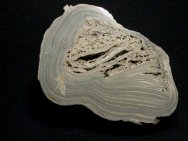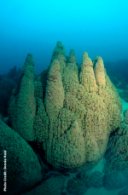|  This
is for all practical purposes, modern stromatolite from the
Holocene to pleistocene, coming from the famous selenite collecting
beds of Lake Marion, Australia. In fact, the specimen contains
crystals of selenite. The specimen also exhibits extremely
fine layering. The material is difficult to obtain, coming
only from old collections, as the site is now a protected park.
Coming from a lake/lagoon environment with brackish and hypersaline
water, this stromatolite is an example of how modern stromatolite
has retreated to less hospital habitats where competition from
other forms is reduced and where the bacterial mats This
is for all practical purposes, modern stromatolite from the
Holocene to pleistocene, coming from the famous selenite collecting
beds of Lake Marion, Australia. In fact, the specimen contains
crystals of selenite. The specimen also exhibits extremely
fine layering. The material is difficult to obtain, coming
only from old collections, as the site is now a protected park.
Coming from a lake/lagoon environment with brackish and hypersaline
water, this stromatolite is an example of how modern stromatolite
has retreated to less hospital habitats where competition from
other forms is reduced and where the bacterial mats  will not
become part of the food chain. Being more modern, this domal
section of stromatolite has apparently retained its form from
when the colony was alive and growing. Unlike most ancient
stromatolite, it has not been metamorphosized. Marion Bay is
now a park with no access to collectors, making this specimen
from an old collection impossible to replace. will not
become part of the food chain. Being more modern, this domal
section of stromatolite has apparently retained its form from
when the colony was alive and growing. Unlike most ancient
stromatolite, it has not been metamorphosized. Marion Bay is
now a park with no access to collectors, making this specimen
from an old collection impossible to replace.
During
much of precambrian time, microbial mats built massive near-shore
reef
systems across a planet with a paleoenvironment hostile to
modern life. These reef building prokaryotes where mostly photosynthetic
(e.g., cyanobacteria). The coasts provided water shallow enough
to gather visible spectrum light for energy, while affording
some attenuation to the prevailing, deadly ultraviolet light.
By the
Cambrian, the buildup of atmospheric oxygen as by product of
photosynthesis was powering an explosion of eukaryotic life,
including many who
would be the new reef builders from the Paleozoic to modern time
If fact, the microbial mats formed by prokaryotic bacteria (slang
name is blue-green algae owning to pigmentation involved in photosynthesis)
became part of the food chain for the new life forms. Stromatolites
as shown here from Marion Bay in Australia are modern stromatolites
now only found on earth in areas where there is reduced grazing
and burrowing by other organisms, and a low occurrence of macro-algae
and plants. Environments where modern stromatolites are typically
found are hypersaline, but also include areas of high alkalinity,
low nutrients, high or low temperatures, and strong wave or current
actions. The obvious pattern emerges that modern stromatolites
tend to exist in areas that most other life forms consider less
desirable or possibly intolerable. Thus, organisms producing
modern stromatolites are generally limited to areas where organisms
with
which they have to compete and/or organisms that might use them
for nutrients are not prevalent.
Also
see: Stromatolites Across Geologic Time |




